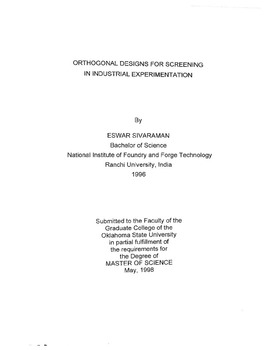| dc.description.abstract | This research is about the design of experiments, and the combinatorial problems that are intrinsic to the subject. The poss,ibility of being able to make judgmental decisions to control or modify a process, s'elect (or deseiect) significant (or trivial) factors based on information gathered from very few runs, in what is commonly referred to as screening experimentation is very optimistic, both in its scope and importance .. However, the design plans applicable for such experiments, whi le being simple in concept and creation for symmetrical experiments, pose interesting challenges for the case of asymmetrical experiments, both in attempting a generic tractable solution and remaining true to their intent, i.e., easy to comprehend and use by the not-so-naive experimenter. To this end, this research attempts to establish and propound a new method for generating orthogonal plans, orthogonality being a necessary attribute of the design plans to maximize �confidence in the screening experiment's outcome(s) and subsequent decisions therefrom. The method of symmetric constructions is the outcome of this research effort and contends as a g,eneric solution methodology for the construction of 2k.,\p (s~2) o.rthogonal plans in s( 1 +k) runs, uses for which are numerous, inasmuch as industrial experimentation is concerned. Also, rules for modifying these design plans, to incorporate any user-specified combination are explored and elaborated. It would only seem fair to admit that this res,earch is incomplete, either in fu lly exploiting this technique or in achieving the desired objective of completely orthogonal estimates of all higher order factor main effects. The design plans constructed using the method of symmetric constructions allow fo r orthogonal estimates of all linear effects while the higher order factor effects (for quantitative factors) are slightly correlated with each other. However, the pros and cons of near-orthogonal arrays are not elaborated in this report. Also, generic design templates for use in the constructions of asymmetrical experiments are derived and presented herein. It is the fond hope of the author that the method of symmetric constructions will find applications in other allied fields as well and in this context, the ideas initiated and shared in this report shall be found useful by interested researchers ill the years to come. | |
